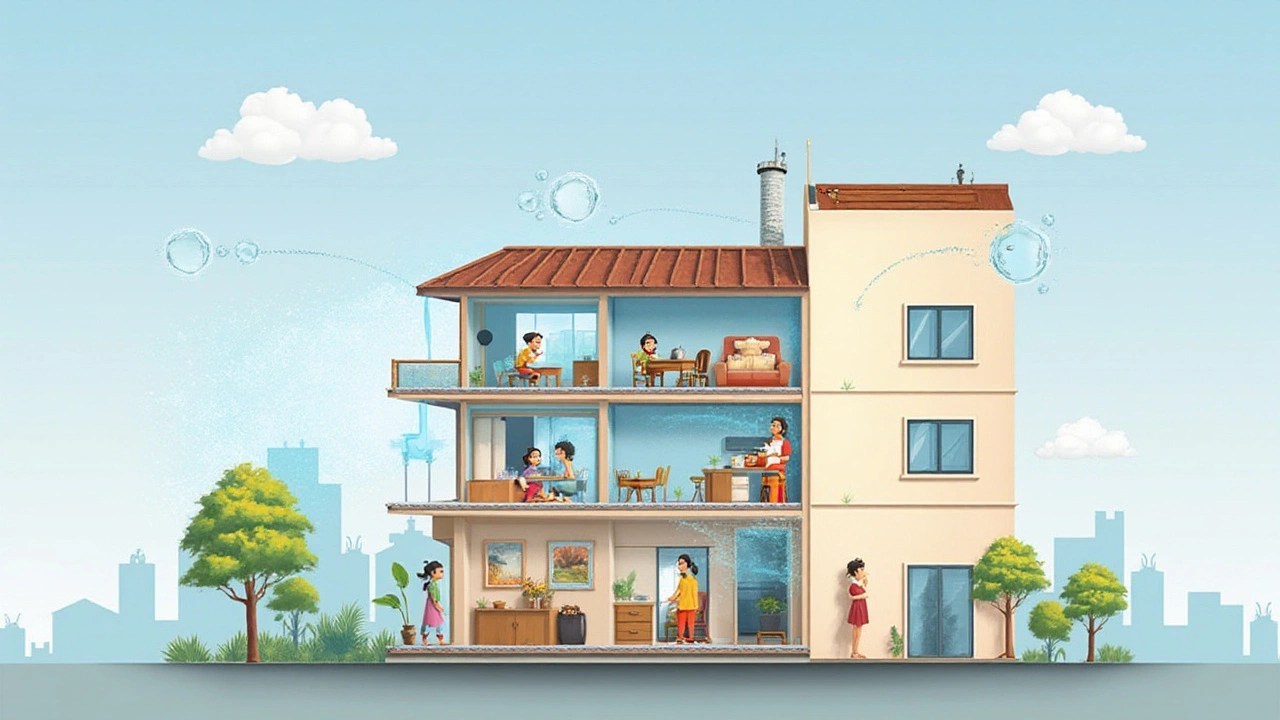Are Filtrete Air Filters a Smart Investment for Your Home?
 Dec, 31 2024
Dec, 31 2024
A breath of fresh air right at home—who wouldn't want that? With air quality being a mounting concern for many, Filtrete filters have stepped into the spotlight. These filters are a recognizable name on the shelf, thanks to their promise to capture tiny particles that are often neglected.
However, the question remains: do Filtrete filters deliver on their promise, and are they worth the dollars spent? Here, we break down what makes Filtrete filters tick, discuss their advantages and disadvantages, analyze the costs, and introduce alternatives. Let's dive in to see if these filters stand up to the hype, and if they’re the right fit for your household's air filtration needs.
- Understanding Filtrete Filters
- Benefits of Using Filtrete Filters
- Potential Drawbacks
- Cost Considerations
- Alternatives to Filtrete Filters
Understanding Filtrete Filters
Filtrete filters are part of a larger dialogue about improving indoor air quality, an important aspect of modern living as people spend a significant amount of time indoors. These filters are designed by 3M, a well-known company that has built a strong reputation over decades for creating innovative technology and products. Filtrete filters stand out due to their use of electrostatically charged fibers, which help attract and capture more particles than fibers that are not charged. This crucial feature ensures that the filters efficiently trap a variety of contaminants, including pollen, mold spores, and even smoke, while maintaining a high airflow level in HVAC systems. In some cases, these filters are said to mitigate odors, thereby subtly enhancing the living environment.
The magic of Filtrete filters lies in their microparticle performance rating (MPR). Unlike the more common Minimum Efficiency Reporting Values (MERV) ratings, MPR is designed specifically by 3M to score airborne particles’ ability to pass through the filter. Their range typically spans from MPR 300 to over 1900, which denotes the filter’s capacity to capture larger to finer particles. For instance, regular home filters often reach for the 700 range, apt for trapping common particles like dust and mold, while the higher MPR of 1900 aims to capture microscopic particles such as viruses and ultrafine pollutants. This rating system helps consumers choose a filter based on specific household needs, particularly if family members suffer from allergies or respiratory issues.
"As one of the most highly regarded filters on the market, Filtrete has succeeded in striking an ideal balance between efficiency and accessibility," notes a publication from Consumer Reports, underscoring the brand's consistent acclaim.
Durability and lifespan are other key staplings of the Filtrete brand. The company typically recommends replacing their filters every three months to ensure optimal performance, although variations might occur depending on the environment, such as proximity to pollution or household pets. Many homeowners appreciate the robust yet practical construction which enables them to manage indoor air with less frequent interventions. Filters for HVAC systems like those from Filtrete not only help in protecting the unit itself from dust and debris but also play a part in ensuring energy efficiency by allowing the system to run smoothly without overexertion. Choosing the right filter, like one from the Filtrete family, could not only mean cleaner air but also savings on electricity bills.
Benefits of Using Filtrete Filters
When it comes to ensuring clean, breathable air in your home, a Filtrete filter acts like an unsung hero, working tirelessly behind the scenes. These filters are engineered to capture a vast array of airborne particles, making your indoor environment healthier. One of the standout benefits is their effectiveness in filtering out allergens such as pollen and dust mite debris. For those sensitive to seasonal allergies, having a defense like this can make a remarkable difference in daily comfort.
Another critical benefit of Filtrete filters is their ability to trap microscopic particles that other filters might miss. With their advanced electrostatic technology, they create a positive charge that actively attracts negatively charged particles. This technology means that they capture more dust, smog, and pet dander than ordinary fiberglass filters. In fact, evidence suggests that these filters can capture up to 99% of large airborne particles, significantly enhancing indoor air quality.
Energy Efficiency and Cost Savings
Beyond purifying your air, Filtrete filters contribute to energy efficiency. A clean air filter ensures that your HVAC system doesn’t work harder than necessary, which in turn reduces your energy consumption and utility bills. The U.S. Department of Energy supports this, stating that consistently replacing air filters can lower your air conditioner's energy use by up to 15%. This makes Filtrete filters not just a health asset but also a smart financial choice over time.Moreover, Filtrete filters come with a durable design that often needs replacement only every three months – a detail that's appreciated by those leading busy lives. With reminders available on certain products – thanks to Filtrete’s partnerships with apps and devices – it becomes effortless to keep track of when a replacement is due, ensuring your air stays consistently clean.
"Filtrete filters combine science and user-friendly application to provide clean air without hassle," says a representative from the American Lung Association.
Sustainability and Eco-Friendly Considerations
Environmentally conscious shoppers will also appreciate the sustainable aspects of Filtrete filters. Many of their filters are made with fully recyclable materials. This helps reduce the carbon footprint associated with manufacturing and disposal, making them a thoughtful choice for the planet, as well as your home. Pairing your Filtrete filter use with good ventilation habits and regular cleaning can further improve air quality sustainably.To sum it up, the benefits of using Filtrete filters are multifaceted. From improving health by reducing allergens to saving on energy costs, and contributing positively to environmental sustainability, they offer compelling reasons for why they may be worth the investment. While cost and brand name can initially seem like barriers, these advantages often translate to long-term savings and improved quality of life.

Potential Drawbacks
Like any product, Filtrete filters have their fair share of drawbacks that are worthy of consideration before making a purchase decision. First and foremost, the cost can be a significant factor. While offering premium air filtration capability, Filtrete filters tend to be on the pricier side, especially their higher-rated MPR (Microparticle Performance Rating) options that promise to capture the finest particles. Over the long term, the cumulative cost of purchasing these high-end filters can add up quickly. Depending on the frequency of replacement and the specific model used, homeowners might find themselves shelling out more than they initially anticipated.
Another concern circles around the filter's resistance to air flow. This is particularly the case for filters with higher efficiency ratings; they often restrict airflow more compared to standard filters. Such restriction can inadvertently place additional strain on your HVAC system, potentially leading to an increase in energy consumption and wear and tear over time. This is a particularly pertinent point if you have an older system that might not handle the impedance well. Consulting with your HVAC professional before installing a higher-rated Filtrete filter might save you from unwanted surprises later on.
Moreover, there have been discussions in consumer forums regarding the appropriate frequency of filter changes. Filtrete advocates often recommend replacement every three months under normal circumstances to maintain optimal performance. However, depending on specific environmental factors—such as pets, location, or particular allergies—some users find themselves needing to replace filters more frequently. This frequent changing can amplify the total cost of using these filters.
In a conversation about the long-term practicality of such filters, Home Improvement Magazine once quoted, “It's crucial to weigh the balance between cost and air quality improvement. The key is to align your filter choices with your home's specific needs and your overall budget.”
Lastly, some users have reported environmental concerns regarding the disposal of these filters. While enhancing indoor air quality, the materials used in making these efficient filters aren't always environmentally friendly or biodegradable. Conscious consumers are often torn between reaping health benefits for their household and contributing minimally to environmental waste. This aspect might not be a dealbreaker for everyone, but it is certainly a vital consideration for those interested in sustainable living.
Cost Considerations
When it comes to integrating Filtrete filters into your home's air circulation system, understanding the cost dynamics is crucial. The upfront price of these filters may seem like a hurdle to some, as high-quality air filters can range significantly in price based on their MERV (Minimum Efficiency Reporting Value) rating—the higher the rating, the more expensive the filter. However, these upfront costs must be weighed against their potential health benefits and savings in terms of household maintenance.
This leads us to consider their durability. Filtrete filters need replacement at regular intervals, typically once every three months. For some, this regular cost may add up; nonetheless, using a high-performance filter could potentially decrease the frequency of more expensive HVAC repairs and maintenance, keeping your systems running smoothly for longer.
To put things into perspective, while standard fiberglass filters might cost less initially, their inability to trap smaller pollutants could lead to a compromised air quality, possibly resulting in increased medical expenses for sensitivities or allergies. Filtrete filters, in contrast, are designed to capture allergens and microscopic particles, improving household air quality significantly.
According to the American Lung Association, using a well-functioning air filtration system can reduce the airborne contaminants that exacerbate asthma and other respiratory issues.
Evaluating the true cost of Filtrete filters also involves examining energy savings. A clean filter reduces strain on an HVAC system, improving efficiency and potentially leading to lower electricity bills. The investment might seem weighty in the short-term, yet the long-term benefits often offset initial spending. It's essential not to overlook filter subscription services which several retailers offer these days. These services can provide a more budget-friendly approach, delivering new filters at regular intervals and thereby ensuring consistent air quality without requiring frequent trips to the store.
Let’s not forget about potential discounts and loyalty programs that can make Filtrete filters even more cost-effective. Retailers often partner with filter manufacturers like Filtrete to bring special promotions, so keeping an eye out for seasonal sales or bulk purchase discounts could stretch each dollar further. For avid do-it-yourself fans, installing or changing filters is a breeze, cutting down possible installation costs, and ensuring you’re always on top of maintaining your indoor environment.

Alternatives to Filtrete Filters
When considering alternatives to Filtrete filters, it's important to weigh options that suit specific needs for air filtration in your home. Different filters cater to different priorities—be it budget, filter lifespan, or specialized air quality concerns like allergies or smoke. A plethora of alternatives exists, each with unique strengths and potential drawbacks. By exploring these, homeowners can find a filter better aligned with their personal requirements.
One alternative is HEPA filters, renowned for their efficiency in trapping particles as small as 0.3 microns with a 99.97% efficiency rate. HEPA filters are particularly beneficial for allergy sufferers as they capture pollen, pet dander, and dust mites. Unlike Filtrete's focus on larger debris, HEPA filters excel in environments where microscopic allergens are the main culprits.
According to the Environmental Protection Agency (EPA), 'true HEPA filters are often recommended by professionals for achieving the best indoor air quality.'However, it’s worth noting that HEPA filters can be more expensive and require frequent replacements due to their high filtration capacity, which may not be suitable for all budgets.
Another popular choice is electrostatic filters, which leverage static electricity to capture particulate matter. These filters, which can be either disposable or washable, are favored for their eco-friendliness and potential cost savings over time. Washable electrostatic filters eliminate the recurring cost of replacements, as they can be reused after a simple cleaning process. While they don’t match the particle-capturing prowess of HEPA filters, they offer sufficient protection for everyday dust and lint, making them a reasonable choice for those seeking a balance between cost-effectiveness and performance.
Carbon filters stand out as another option, especially in households with concerns about odors and chemical pollutants. These filters excel at neutralizing smoke, gases, and other volatile organic compounds, something that neither Filtrete nor HEPA filters handle as effectively. Activated carbon filters are often paired with other types of filters to create a comprehensive filtration system. Despite their advantages, carbon filters may need frequent changing, especially if they are tasked with high levels of odor and smoke, which is something to consider in terms of ongoing maintenance costs.
For tech-savvy homeowners, smart air filters that integrate with home automation systems present a modern alternative. These filters often come equipped with sensors and Wi-Fi connectivity allowing real-time air quality monitoring and notifications when replacements are due. Brands like Blueair and Molekule offer devices that not only filter the air but also provide insights into the indoor environment, something traditional filters cannot offer. These can be costly, but they provide unmatched convenience and information, appealing to those living in smart homes.
Finally, those in search of budget alternatives might consider fiberglass air filters. These filters are the most basic in air filter technology and are often used to protect HVAC systems rather than improve air quality. They’re inexpensive and can be found in bulk packs, but their ability to filter out finer particles like those that cause allergies often falls short. Hence, they’re best suited for scenarios where the primary concern is maintaining airflow and mechanical protection rather than significant air purification.
To help compare some of these alternatives, here's a simple comparison:
| Filter Type | Efficiency | Advantages | Drawbacks |
|---|---|---|---|
| HEPA | 99.97% for 0.3 microns | Excellent for allergies | Expensive, requires frequent change |
| Electrostatic | Varies | Eco-friendly, reusable | Less effective on small particles |
| Carbon | Moderate to high | Great for odors | Frequent changes required |
| Smart | High | Data-driven, convenient | High initial cost |
In the vast sphere of air filter choices, there's certainly a compelling alternative to Filtrete filters for every homeowner. Whether prioritizing cost, effectiveness, or technology, exploring these alternatives can guide you to the best option for your living space. The perfect filter not only promises cleaner air but also peace of mind knowing your home environment supports your health and well-being.